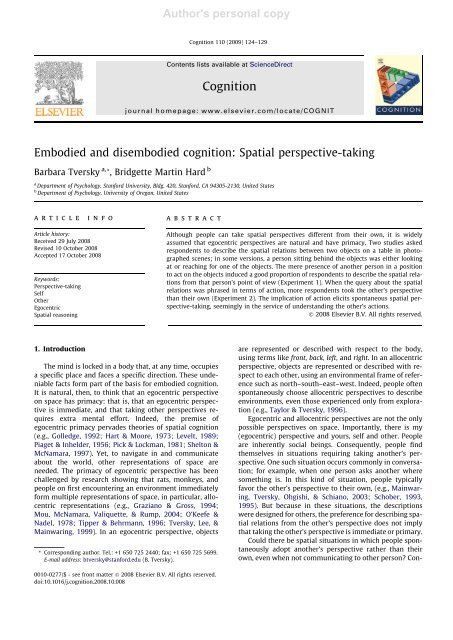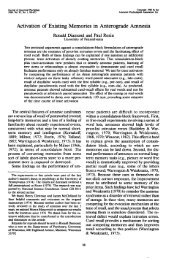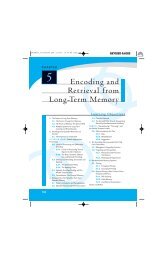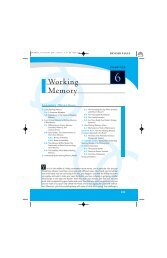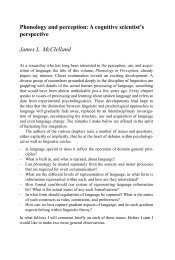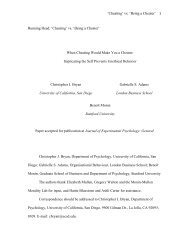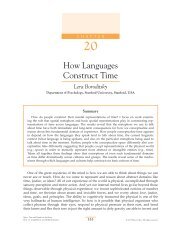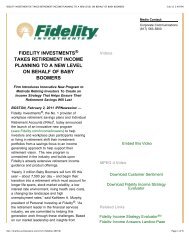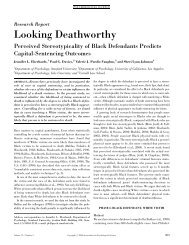Embodied and disembodied cognition: Spatial perspective-taking
Embodied and disembodied cognition: Spatial perspective-taking
Embodied and disembodied cognition: Spatial perspective-taking
Create successful ePaper yourself
Turn your PDF publications into a flip-book with our unique Google optimized e-Paper software.
Author's personal copy<br />
<strong>Embodied</strong> <strong>and</strong> <strong>disembodied</strong> <strong>cognition</strong>: <strong>Spatial</strong> <strong>perspective</strong>-<strong>taking</strong><br />
Barbara Tversky a, *, Bridgette Martin Hard b<br />
a Department of Psychology, Stanford University, Bldg. 420, Stanford, CA 94305-2130, United States<br />
b Department of Psychology, University of Oregon, United States<br />
article info<br />
Article history:<br />
Received 29 July 2008<br />
Revised 10 October 2008<br />
Accepted 17 October 2008<br />
Keywords:<br />
Perspective-<strong>taking</strong><br />
Self<br />
Other<br />
Egocentric<br />
<strong>Spatial</strong> reasoning<br />
1. Introduction<br />
abstract<br />
The mind is locked in a body that, at any time, occupies<br />
a specific place <strong>and</strong> faces a specific direction. These undeniable<br />
facts form part of the basis for embodied <strong>cognition</strong>.<br />
It is natural, then, to think that an egocentric <strong>perspective</strong><br />
on space has primacy: that is, that an egocentric <strong>perspective</strong><br />
is immediate, <strong>and</strong> that <strong>taking</strong> other <strong>perspective</strong>s requires<br />
extra mental effort. Indeed, the premise of<br />
egocentric primacy pervades theories of spatial <strong>cognition</strong><br />
(e.g., Golledge, 1992; Hart & Moore, 1973; Levelt, 1989;<br />
Piaget & Inhelder, 1956; Pick & Lockman, 1981; Shelton &<br />
McNamara, 1997). Yet, to navigate in <strong>and</strong> communicate<br />
about the world, other representations of space are<br />
needed. The primacy of egocentric <strong>perspective</strong> has been<br />
challenged by research showing that rats, monkeys, <strong>and</strong><br />
people on first encountering an environment immediately<br />
form multiple representations of space, in particular, allocentric<br />
representations (e.g., Graziano & Gross, 1994;<br />
Mou, McNamara, Valiquette, & Rump, 2004; O’Keefe &<br />
Nadel, 1978; Tipper & Behrmann, 1996; Tversky, Lee, &<br />
Mainwaring, 1999). In an egocentric <strong>perspective</strong>, objects<br />
* Corresponding author. Tel.: +1 650 725 2440; fax: +1 650 725 5699.<br />
E-mail address: btversky@stanford.edu (B. Tversky).<br />
0010-0277/$ - see front matter Ó 2008 Elsevier B.V. All rights reserved.<br />
doi:10.1016/j.<strong>cognition</strong>.2008.10.008<br />
Cognition 110 (2009) 124–129<br />
Contents lists available at ScienceDirect<br />
Cognition<br />
journal homepage: www.elsevier.com/locate/COGNIT<br />
Although people can take spatial <strong>perspective</strong>s different from their own, it is widely<br />
assumed that egocentric <strong>perspective</strong>s are natural <strong>and</strong> have primacy. Two studies asked<br />
respondents to describe the spatial relations between two objects on a table in photographed<br />
scenes; in some versions, a person sitting behind the objects was either looking<br />
at or reaching for one of the objects. The mere presence of another person in a position<br />
to act on the objects induced a good proportion of respondents to describe the spatial relations<br />
from that person’s point of view (Experiment 1). When the query about the spatial<br />
relations was phrased in terms of action, more respondents took the other’s <strong>perspective</strong><br />
than their own (Experiment 2). The implication of action elicits spontaneous spatial <strong>perspective</strong>-<strong>taking</strong>,<br />
seemingly in the service of underst<strong>and</strong>ing the other’s actions.<br />
Ó 2008 Elsevier B.V. All rights reserved.<br />
are represented or described with respect to the body,<br />
using terms like front, back, left, <strong>and</strong> right. In an allocentric<br />
<strong>perspective</strong>, objects are represented or described with respect<br />
to each other, using an environmental frame of reference<br />
such as north–south–east–west. Indeed, people often<br />
spontaneously choose allocentric <strong>perspective</strong>s to describe<br />
environments, even those experienced only from exploration<br />
(e.g., Taylor & Tversky, 1996).<br />
Egocentric <strong>and</strong> allocentric <strong>perspective</strong>s are not the only<br />
possible <strong>perspective</strong>s on space. Importantly, there is my<br />
(egocentric) <strong>perspective</strong> <strong>and</strong> yours, self <strong>and</strong> other. People<br />
are inherently social beings. Consequently, people find<br />
themselves in situations requiring <strong>taking</strong> another’s <strong>perspective</strong>.<br />
One such situation occurs commonly in conversation;<br />
for example, when one person asks another where<br />
something is. In this kind of situation, people typically<br />
favor the other’s <strong>perspective</strong> to their own, (e.g., Mainwaring,<br />
Tversky, Ohgishi, & Schiano, 2003; Schober, 1993,<br />
1995). But because in these situations, the descriptions<br />
were designed for others, the preference for describing spatial<br />
relations from the other’s <strong>perspective</strong> does not imply<br />
that <strong>taking</strong> the other’s <strong>perspective</strong> is immediate or primary.<br />
Could there be spatial situations in which people spontaneously<br />
adopt another’s <strong>perspective</strong> rather than their<br />
own, even when not communicating to other person? Con-


